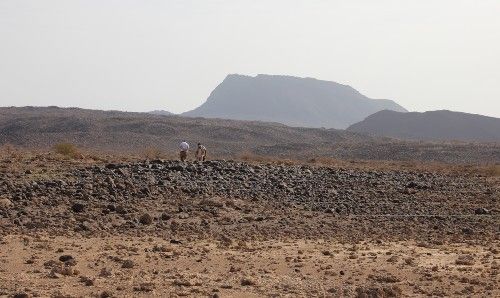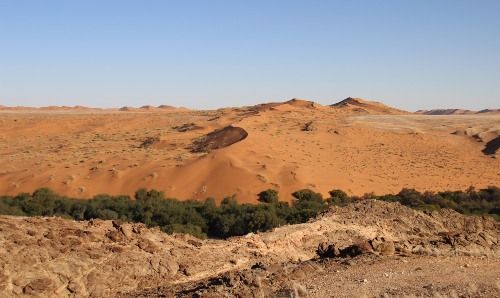
Quaternary Environments and Geoarchaeology (QEG)
Quaternary Environments and Geoarchaeology (QEG) is an international group exploring the interface of Quaternary climate changes and landscape dynamics in diverse global systems.

Our strength is in investigating human-environment interactions and past climate dynamics and responses across and between the Earth’s five 'spheres'.
These five 'spheres' are cryosphere, hydrosphere, lithosphere, biosphere, and atmosphere.
Our world-class laboratory facilities underpin our research outputs.

They allow us to drive forward novel methodological techniques in Quaternary science, such as pollen geochemistry and field-portable luminescence.
QEG’s world-leading research draws upon our numerous productive international and national partnerships, including analytical facilities and academic collaborators.
Our research
Climate systems
We explore the social and physical science of past, present and future climate change and its interactions with society. This includes the social science of how climate change and proposed solutions to it are perceived, evaluated, and governed.
We also investigate the physical science of past climate dynamics, including palaeoclimate, ice sheets and sea-level.
Themes
- Responsible incentivisation of methods for removing carbon dioxide from the atmosphere
- Governance of ideas for managing solar radiation and cooling the Earth
- Perceptions of tipping points in the Earth’s climate system and understanding mechanisms for tipping social systems
- Social construction of ‘natural’ and ‘nature-based’ solutions to climate change
Projects
Dryland systems
We explore the hydroclimatic and environmental changes that dryland regions have experienced through the Quaternary, with particular focus on Africa and the Arabian Peninsula.
These are expressed at the surface in the landforms and landscapes of dryland, and also beneath the surface in the hydrogeological record.
Themes
- Quaternary history of the River Nile basin: geomorphological and hydrological changes
- Quaternary landscape dynamics within the Namib Sand Sea and the Kalahari, Southern Africa
- Rapid age assessment of dryland landscape dynamics using a portable luminescence reader
- The unsaturated zone as a novel archive for Quaternary environmental change
- Using terrestrial carbonates to reconstruct palaeohydrology and palaeoenvironmental change
Projects
- Nitrate beneath the surface in drylands
- Rainfall in the Desert Sand: First application of chemical tracers to Kalahari dunes to investigate past fluctuations in rainfall and changing recharge rates to groundwater in the Stampriet Aquifer
- U-Th and 40Ar/39Ar Dating of Palaeolithic Landscapes at Wadi Dabsa, southwest Saudi Arabia
Ecosystems
We investigate environmental responses to Quaternary climate change, with a strong research focus on North Africa, Mediterranean and North-West European ecosystems.
We aim to elucidate the natural and anthropogenic drivers of past environmental changes.
Our research examines ecosystem changes through the study of fossil pollen, diatoms, chironomids and a range of other proxies in peat, lake and marine cores.
Themes
- Environmental history of the Marrakesh High Atlas
- Geochemical signatures of environmental change in pollen of Atlas cedar
- Palaeoecology and human-environment relations across the Mesolithic-Neolithic transition
- Palaeoecology of open peatlands in the Peruvian Amazon
- Palaeoenvironmental change in the Middle Atlas, Morocco
- Rapid vegetation and climate changes during the last glacial in the Iberian Peninsula
Projects
Geoarchaeology
We use palaeoenvironmental proxies and geochronology to investigate and reconstruct past physical landscapes inhabited by hominin populations.
These environmental and climatic reconstructions inform archaeological theories about hominin migration and dispersal, hominin activities and the impact of our species on the landscape.
There are strong links with the Manchester Centre for Archaeology and Egyptology (MCAE).
Themes
- Environmental impact of Late Mesolithic (hunter-gatherer) cultures
- Human activity and environmental change in the Nile Valley of Northern Sudan
- The Palaeolithic Landscapes near Mokopane, Limpopo Province, South Africa
- The Palaeolithic Landscapes of Wadi Dabsa, Saudi-Arabia
- The transition from Mesolithic hunter-gathering to Neolithic farming in North-West Europe
Projects
Glacial systems
We work on reconstructing the timing and nature of past glacial systems, from alpine glaciers to continental ice sheets.
Our research provides a long-term context for changes in past and present glacial processes.
We make use of glacial landform and sediment records, glacier and climate models, and chronological tools such as radiocarbon dating, cosmogenic nuclide exposure dating and luminescence dating.
Themes
- Cosmogenic nuclide dating of outwash sediments in Patagonia
- Palaeoglaciology of the Eurasian ice sheets
- Global glacier dynamics during 100 ka Pleistocene glacial cycles
- The retreat of the Western Cordilleran Ice Sheet Margin During the Last Deglaciation
- Timing of glacial retreat in the Wicklow Mountains, Ireland
Projects
River systems
We undertake a diverse range of research activities related to rivers spanning the present, recent historical past and Quaternary timescale.
Themes
- Micro- and macro-plastics pollution in industrial rivers
- River behaviour as a driver of landscape change in the Quaternary with a focus in the Mediterranean region
Our people
Post-doctoral researchers
- Ben Bell
- Dael Sassoon
PhD students
Current PhD students
- Jessica Gauld
- Susan Hancock
- Shashank Nitundil
- Mohammad Sepehr Akhavan Kharazian (Joint PhD with University of Melbourne)
- Oliver Thomas
- Tianyuan Wang
Former PhD students
- Kathryn Adamson
- James Allard
- Ben Bell
- Alison Burns
- Jennifer Campbell
- Henk Cornelissen
- Joanne Egan
- Sandra Gomes
- Madeleine Hann
- Rachel Hurley
- Sarah Kneen
- Jiawei Li
- Mike Morley
- Dael Sassoon
- Barry Taylor
- Matt Tomkins
- Rose Wilkinson
Potential PhD projects
Looking for a PhD? Want to join our diverse research team? We want to hear from you.
Members of QEG are keen to supervise projects on any of our five research themes and welcome expressions of interest at any time.
Our studentships are not part of a Doctoral Training Partnership (DTP), which means we are not constrained by particular project goals and prefer to formulate projects collaboratively with prospective students.
We are keen to help students develop projects that they find exciting and interesting and suit their own research goals and agenda.
Deadlines for applications are the end of January, with successful applicants notified by late April (for an October start).
Visiting fellows and emeritus staff
- Roger Braithwaite
- Richard Huggett
- Annegret Larsen
Events
William Boyd Dawkins Lecture Series
| Year | Speaker | Title |
|---|---|---|
| 2020 | Danielle Schreve, Royal Holloway University of London | Our beastly past: vertebrate responses to abrupt climate change during the last 60,000 years in Britain |
| 2017 | Jill Cook, Natural History Museum | Ice Age Art and the Human Environment in Europe 40,000 to 10,000 years ago |
| 2015 | Tom Higham, University of Oxford | Time for the Palaeolithic: Radiocarbon dating, the Neanderthal demise, and the arrival of Modern Humans in Europe |
| 2014 | Paul Pettitt, Durham University | Cave hunting 140 years on: Late Ice Age humans in Britain |
| 2012 | Adrian Lister, Natural History Museum | Ice Age Mammals and Environmental Change |
